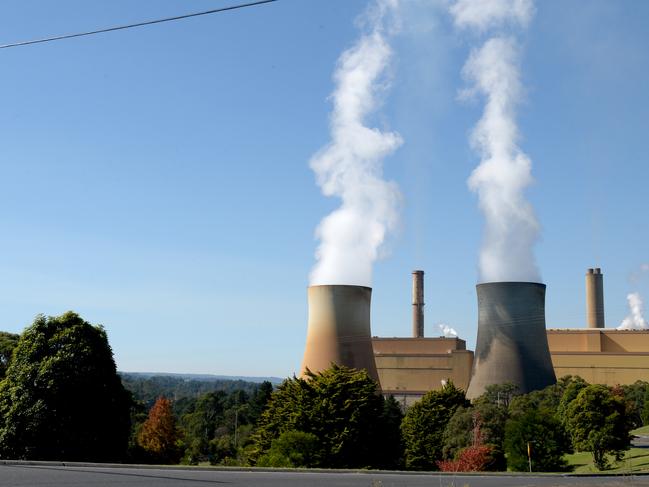Deal to keep Victoria's dirtiest power station running to 2028 could be extended
Extending a deal that keeps Victoria’s dirtiest power stationrunning to 2028 is likely to be considered in a bid for extra “insurance” to keep the lights on during the transition to renewables.
Victoria
Don't miss out on the headlines from Victoria. Followed categories will be added to My News.
Extending a deal that keeps Victoria’s dirtiest power station running to 2028 is likely to be considered due to gas shortages and the risk of energy project delays.
The bid for extra “insurance” to keep the lights on during the transition to renewables comes amid growing calls for secret agreements currently in place to ensure coal-fired generators will keep functioning for the next decade, be made public.
Victoria is less than four years from a deadline set for the closure of Yallourn power station in the Latrobe Valley, which can supply up to a fifth of the state’s electricity when running at full capacity.
The ageing generator’s retirement was brought forward by owner Energy Australia three years ago due to increased costs and energy price changes, but the Andrews government struck a secret “safety net” deal to ensure it would not pull the plug earlier and leave the state’s energy supplies in chaos.

State Budget papers show that “under certain scenarios” the State would “provide partial support to EA (Energy Australia) in the event of exceptional costs incurred in the operation of the Yallourn Power Station”.
The government has refused to detail what the certain scenarios would include, or how much taxpayers would fork out under those scenarios, and has ignored a recent parliamentary direction to produce documents.
Energy experts say extra insurance is necessary due to risks on the road to net zero, but that details should be released.
They also say that even if the state wanted to ink a fresh deal, it may not be possible due to mounting costs of keeping ageing generators running.
Opposition Leader John Pesutto recently flagged he would be open to an extension of the power station if he was elected, if the opportunity was there.
An Energy Australia spokesman said Yallourn’s closure was scheduled to close on 30 June, 2028 and the company was committed to that date “without extension”.

He said that to keep a 50-year-old asset safe and reliable will “require considerable capital investment” and that $400m was spent in 2023 and 2024 to ensure it would operate until 2028, and was investing in batteries and other firming technology to assist the transition.
Energy project director at think tank the Grattan Institute, Tony Wood, said the government must be looking at options “continually” to manage the risk of power shortfalls if things don’t go to plan this decade.
“Sometimes in life you take out insurance and then you say my house didn’t burn down, that was a waste of money,” he said.
“It’s about managing risk, in my view it’s quite sensible to continue to assess these risks and if things have changed, then they should respond.”
Mr Wood said secret deals between taxpayers and the owners of Yallourn and Loy Yang power stations to ensure they stayed open as scheduled should be disclosed.
Victoria Energy Policy Centre director, Bruce Mountain, said current plans to close Yallourn in 2028 were too ambitious given the state’s current trajectory.
He said there was widespread industry concern about the ability of Victoria to expand alternate energy sources in time, and the state was lagging behind a workable timeline.
“To find an alternative source of energy for the power station, Victoria essentially needs to grow those alternate sources as much over the next three years, as it has over the last five,” he said.
“It will have to start growing much more quickly than it has in the past.”

Mr Mountain said it was difficult to see how that could be done, and plans to build a 500kV transmission line from NSW to Victoria were almost four years behind schedule.
“If they close Yallourn by 2028 they’ll probably need to ramp up gas production as a substitute, and that will drive up electricity prices,” he said.
“It’s certainly not a straightforward proposition that it can close.”
Mr Mountain said Victoria had chosen the “slow road” in its transition to wind and solar by favouring large-scale projects, and warned offshore wind projects could end up being “horrifically expensive”.
Australian Industry Group energy expert, Tennant Reed, said the plan to bring on more renewable and boost transmission lines – such as the 500kV transmission lines in western Victoria – could be achieved, but significant delays would cause chaos.
“The existing deal (with Yallourn) is an insurance policy. Do we need insurance on insurance, well, maybe,” he said.
But he said a deal would have high costs, mediocre reliability, and more emissions and “we should be able to do better than that”.

Experts contacted by the Herald Sun said a shortfall in gas was also causing headaches, because until batteries – which were coming online quickly – were able to do the heavy lifting that gas-fired peaking plants could do, they would be needed in the transition.
Mr Reed said there was a risk of major gas shortages within about three or four years.
One Allan government minister said there had been significant back and forth between Climate Change Minister Lily D’Ambrosio and Treasurer Tim Pallas over the transition issue, but that decision on extending coal power station agreements had not reached Cabinet.
They said the government was not “anti gas” and that it would inevitably play a role in helping safeguard supplies, while any shift in coal use could impact on legislated climate change targets, which include reducing emissions below 2005 levels by 45-50 per cent by 2030, and by 75-80 per cent by 2035.



